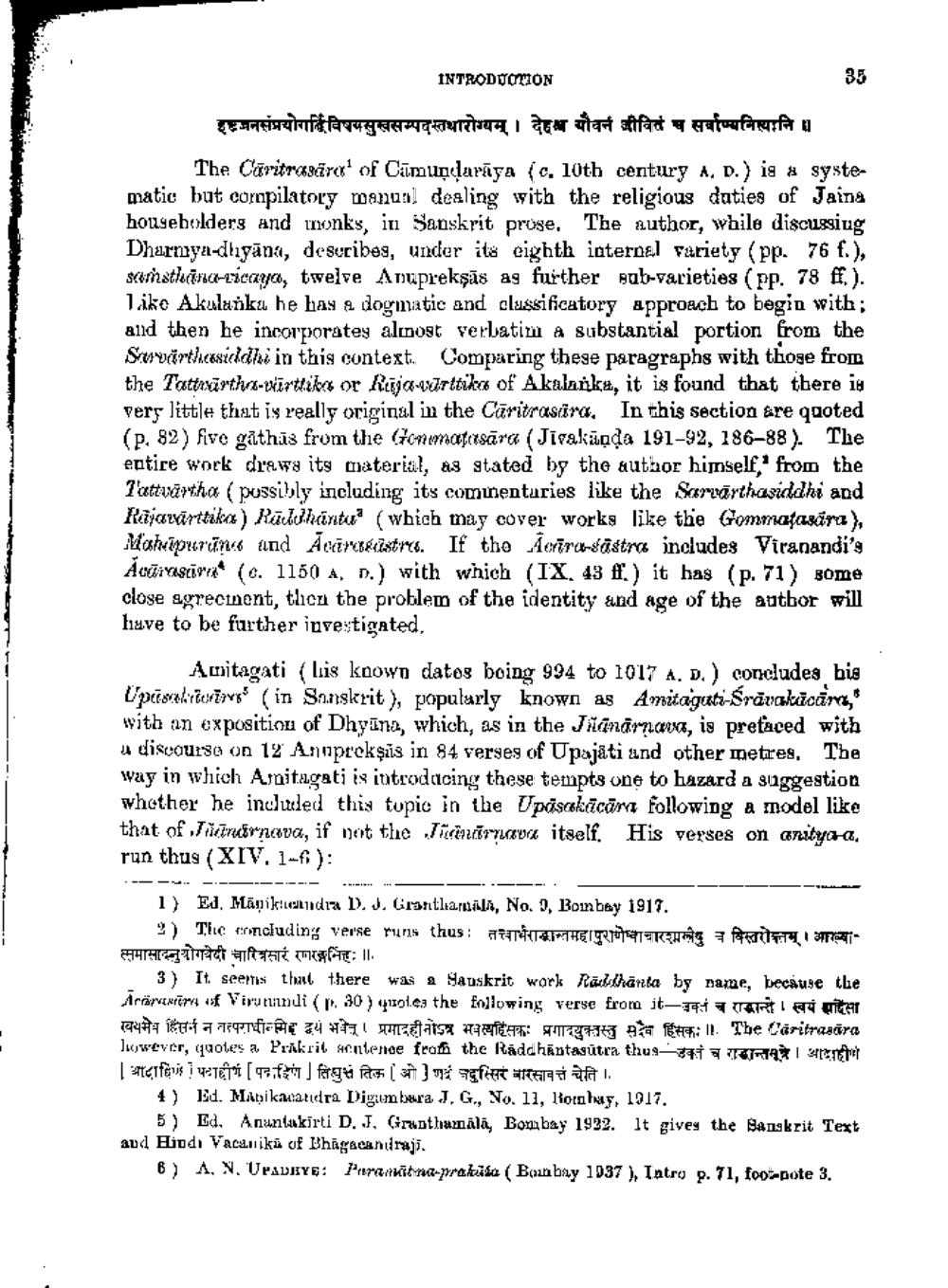________________
INTRODUCTION
35
इष्टजनसंप्रयोगर्दिविषयसुखसम्पदस्तथारोग्यम् । देहश्व यौवनं जीवितं च सर्वाप्यनित्यानि ॥
The Caritrasara' of Camundaraya (c. 10th century A. D.) is a systematic but compilatory manual dealing with the religious duties of Jaina householders and monks, in Sanskrit prose. The author, while discussing Dharmya-dhyana, describes, under its eighth internal variety (pp. 76 f.), samsthana-vicaya, twelve Anuprekṣās as further sub-varieties (pp. 78 ff). Like Akalanka he has a dogmatic and classificatory approach to begin with; and then he incorporates almost verbatim a substantial portion from the Sarvärthasiddhi in this context. Comparing these paragraphs with those from the Tattwartha-virttika or Raja-värttika of Akalanka, it is found that there is very little that is really original in the Caritrasara. In this section are quoted (p. 82) five gathās from the Gommatusāra (Jīvakāṇḍa 191-92, 186-88). The entire work draws its material, as stated by the author himself,' from the Tattvärtha (possibly including its commentaries like the Sarvärthasiddhi and Rajavarttika) Raddhanta (which may cover works like the Gommatasára), Mahapurung and Acarasastra. If the Aera-sastra includes Viranandi's Acarasara (e. 1150 A, D.) with which (IX. 43 ff.) it has (p. 71) some close agreement, then the problem of the identity and age of the author will have to be further investigated.
Amitagati (his known dates being 994 to 1017 A. D.) concludes his Upāsakrior (in Sanskrit), popularly known as Amitaguti-Śrāvakācāra," with an exposition of Dhyana, which, as in the Jianarnava, is prefaced with a discourse on 12 Anupreksis in 84 verses of Upajati and other metres. The way in which Amitagati is introducing these tempts one to hazard a suggestion whether he included this topic in the Upasakācāra following a model like that of Jarnava, if not the Junarnava itself. His verses on anitya-a. run thus (XIV. 1-6):
1) Ed. Manikandra D. J. Granthamala, No. 9, Bombay 1917.
2) The concluding verse runs thus तत्त्वाभैराद्धान्तमाह । पुराणेष्वाचारशास्त्रेषु च विस्तरोक्तम् । आख्यासमासादनु योगवेदी चारित्रसारं राहिः ॥
3) It seems that there was a Sauskrit work Raddhanta by name, because the Arrastra of Virunandi (p. 30) quotes the following verse from it-ti ter स्वयमेव हिंसन तत्पराधी मिह द्वयं भवेत् । प्रमादहीनोऽत्र भवत्यहिंसकः प्रगायुक्तस्तु सदैव हिंसकः ॥ The Caritrasra however, quotes a Prakrit sentence from the Raddhantasūtra thus
| आदाक्षिणं पाही [ प]ि तिघुखं तिक [ ओ ]
दुस्सिर बारसावतं चेति ।
4) Ed. Manikatatudra Digumbara J. G., No. 11, Bombay, 1917.
5) Ed. Anantakirti D. J. Granthamälä, Bombay 1922. It gives the Sanskrit Text and Hindi Vacanika of Bhagacandraji.
6) A. N. UPADHYE: Paramatna-prakita (Bombay 1937), Intro p. 71, footnote 3.




